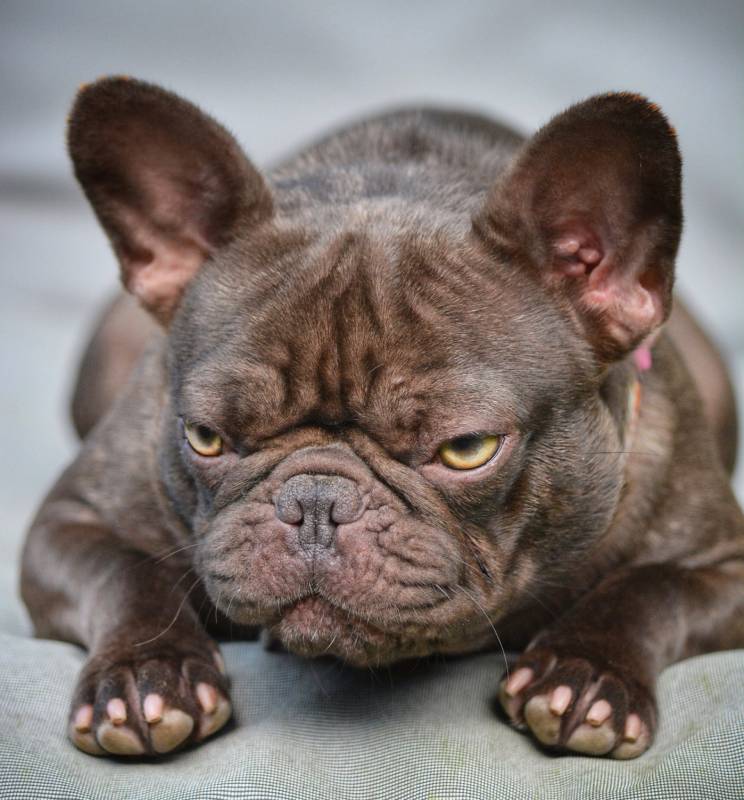Click to Skip Ahead
The Chocolate French Bulldog is a rare coat color of the ever-popular French Bulldog. Fawn, fawn and white, cream, white, white and brindle, white and fawn, brindle, and brindle and white are the standard breed colors recognized by the American Kennel Club, and are the dominant colors for the popular Frenchie.
Breed Overview
Height:
Small to medium (11 – 12 inches)
Weight:
20 – 28 pounds for males, 16-24 pounds for females
Lifespan:
10 – 12 years
Colors:
Fawn, fawn and white, fawn brindle, brindle, brindle and white, cream, white and brindle, white and fawn
Suitable for:
Families looking for a playful, easy-to-groom lapdogs that does not require a lot of space.
Temperament:
Easygoing, sociable, gentle, friendly, playful, affectionate
To breed a Chocolate Frenchie, there must be two copies of a recessive gene, which is a rare occurrence in nature. Some breeding programs are purposefully breeding their dogs to develop Chocolate French Bulldogs—with the puppies costing around $6,500. The history of the Chocolate French Bulldog is the history of the wider species itself. So, to learn more about this adorable brown puppy, we’re going to look at the history of the French Bulldog.
French Bulldog Characteristics

The Earliest Records of Chocolate French Bulldogs in History
The origins of the French Bulldog began when lace makers from Nottingham, England immigrated to Normandy, France during the Industrial Revolution, bringing their Toy Bulldogs with them. In the mid-nineteenth century Paris, the Toy Bulldogs from England were bred with local Rat Terriers to create the Bouledogue Francais or the French Bulldog.
The breeding of the two dogs became so popular that Toy Bulldogs were exported to France— to the point that there were few left in England. Few records were kept of the development of the French Bulldog, as it was bred further away from its parent breed of the Bulldog. The long straight ears are an indicator of the Rat Terrier being crossbred during that timeframe. French Bulldogs were imported into America in 1885 to begin an American breeding program.

How Chocolate French Bulldogs Gained Popularity
French Bulldogs were popular with Parisian prostitutes and high society ladies in France for many years before the dogs came to the United States. In 1896, American society women first showed French Bulldogs at the Westminster Kennel Dog Show. George Raper, a judge, only chose winners that had “rose ears,” which were the standard Bulldog ears that fold at the tip. French Bulldog fanciers formed The French Bull Dog Club of America, and made the “erect bat ear” the breed standard, instead of the English Bulldog “rose ear.”
Formal Recognition of Chocolate French Bulldog
In 1893, the French Bulldog arrived in England, much to the dismay of the English bulldog breeders, as they didn’t want the French stock breeding with the English stocks, due to differences in breed standards. A French Bulldog Club of England was formed in 1902 to help set up a breed standard for the French breed within England. In 1906, official recognition was given to the breed by the Kennel Club.
The French Bulldog was also gaining in popularity in America during the same timeframe the breed was becoming a favorite abroad. In 1897, The French Bulldog Club was formed to help create the breed standard, and the American Kennel Club quickly recognized the new breed in 1898. The breed had continued popularity among high society types, and by 1906, it was one of the most popular dogs in America.

Top 5 Unique Facts About Chocolate French Bulldogs
- Frenchies are loyal companions, but also are intelligent watchdogs.
- The American Kennel Club doesn’t recognize the chocolate color as part of the official breed standard.
- The French Bulldog was ranked number two on the American Kennel Club’s list of Most Popular Dog Breeds in 2021.
- Frenchies are prone to breathing problems, and don’t do well in hot and humid weather.
- A Chocolate Frenchie is very rare, with both the dam and the sire needing to carry the recessive gene to produce a brown French Bulldog.
Do Chocolate French Bulldogs Make Good Pets?
A Chocolate French Bulldog would make a good pet for anyone who wants one of these cute, playful pups. They are good with young children, and are very affectionate with their families. French Bulldogs are excited to meet new people, but can also be protective of their families, as they have a bit of a watchdog streak.
They are intelligent, and can be a little stubborn, but they naturally excel at training since they want to please their owners. Frenchies have a medium energy level, so they would need a short walk every day to keep in shape. They also enjoy canine sports, such as agility, rally, and obedience. French Bulldogs need a weekly brushing session, and nail trims as needed, along with maintaining their facial folds by cleaning and drying them regularly.
Frenchies are a flat-face breed, and are prone to breathing problems, so they don’t do well in humid or hot weather. They can also have skin allergies, juvenile cataracts, cherry eye, and autoimmune skin disorders. Some of these conditions can be screened for, while others can’t. So, check with your breeder to see what they screen for if you’re thinking about purchasing a puppy.
Conclusion
French Bulldogs originally gained prominence in France in the mid-nineteenth century when Nottingham lace makers brought their toy bulldogs to France and bred them with Rat Terriers. The breed was loved by prostitutes and society women alike, and steadily gained in popularity. The breed came to America in 1885, and was recognized by the American Kennel Club in 1898. The French Bulldog migrated back to England in 1893, and was officially recognized as a breed by The Kennel Club in 1906.
This breed has come a long way since its early conception, but its popularity has remained high throughout the years. If you’re looking to purchase the rare Chocolate Frenchie, you’ll come home with a loyal, playful friend for the whole family.
You might also like:
- Brindle French Bulldog: Facts, Origin, Pictures & History
- 9 Common French Bulldog Colors (With Pictures)
Featured Image Credit: Annas_Pfotografie, Shutterstock










